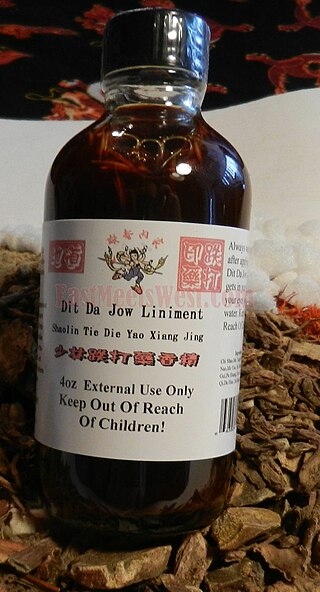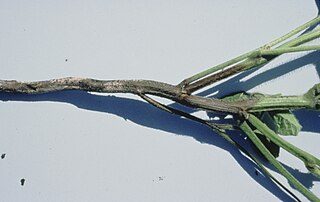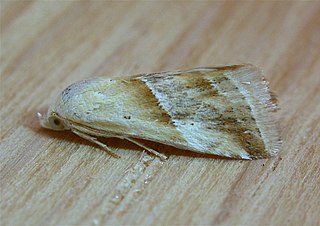
Safflower is a highly branched, herbaceous, thistle-like annual plant in the family Asteraceae. It is commercially cultivated for vegetable oil extracted from the seeds and was used by the early Spanish colonies along the Rio Grande as a substitute for saffron. Plants are 30 to 150 cm tall with globular flower heads having yellow, orange, or red flowers. Each branch will usually have from one to five flower heads containing 15 to 20 seeds per head. Safflower is native to arid environments having seasonal rain. It grows a deep taproot which enables it to thrive in such environments.
gamma-Linolenic acid or GLA is an n−6, or omega-6, fatty acid found primarily in seed oils. When acting on GLA, arachidonate 5-lipoxygenase produces no leukotrienes and the conversion by the enzyme of arachidonic acid to leukotrienes is inhibited.
Heneicosane is the organic compound with the formula CH3(CH2)19CH3. It is the straight chain, saturated C21 hydrocarbon. It is a white wax.

The genus Carthamus, the distaff thistles, includes plants in the family Asteraceae. The group is native to Europe, North Africa, and parts of Asia. The flower has been used since ancient times in the Philippines, which it has been called kasubha by the Tagalog people.

Cistus creticus is a species of shrubby plant in the family Cistaceae. Though it usually has pink flowers, of 4.5–5 cm diameter, this species is very variable. It is widely known as a decorative plant. It is frequently called "Cistus incanus".

Dit da jow is a common Chinese liniment used as traditional medicine in the belief it can reduce the pain from external injuries.

Carthamin is a natural red pigment derived from safflower, earlier known as carthamine. It is used as a dye and a food coloring. As a food additive, it is known as Natural Red 26.

Phytophthora megasperma is a species of water mould in the family Peronosporaceae. It is well known as a plant pathogen with many hosts. It often causes a plant disease called root rot.
Alternaria carthami is a necrotrophic plant pathogen of safflower. The fungus is in the order Pleosporales and family Pleosporaceae. It was first isolated in India, has spread globally and can have devastating effects on safflower yield, and resultant oilseed production. A. carthami is known to be seed-borne and appears as irregular brown lesions on safflower leaves and stems.
In enzymology, a phosphatidylcholine desaturase (EC 1.14.19.22, previously EC 1.3.1.35) is an enzyme that catalyzes the chemical reaction

Carthamus lanatus is a species of thistle known as woolly distaff thistle, downy safflower or saffron thistle. It is closely related to safflower. This annual plant is a native of the Mediterranean Basin, but it is familiar in other places where it was introduced and has become a noxious weed, such as in parts of North America and southern Australia with similar climates.

Larinus curtus is a species of true weevil known as the yellow starthistle flower weevil. It is native to Southern Italy, Southern Europe, the Middle East and the Caucasuses. It is used as an agent of biological pest control against the noxious weed yellow starthistle in the United States.
Tsheringma is a herbal tea made in Bhutan. The name is derived from the Bhutanese goddess of longevity, wealth and prosperity.

Eublemma rivula is a species of moth of the family Erebidae first described by Frederic Moore in 1882. It is found in most of southeast Asia, including Hong Kong, India, Japan, the Society Islands, Taiwan and in Australia in the Australian Capital Territory, New South Wales and Queensland.

Carduncellus is a genus of flowering plants in the tribe Cardueae within the family Asteraceae. They are native to the western Mediterranean and surrounding regions.
Ditaxis heterantha is a member of the plant family Euphorbiaceae and grows wild in Guanajuato, Mexico, where it is known as azafrán, azafrancillo, azafrán de bolita or saffron pellets and has several culinary uses, including as a substitute for saffron. Ditaxis heterantha is not related to true saffron nor to safflower, which also is used as a saffron substitute.
Chaetorellia succinea is a species of tephritid fruit fly that was accidentally released in 1991 into the United States and had since become one of the major biological pest controls against the noxious weed yellow starthistle.
C. tinctoria may refer to:

N-Feruloylserotonin an alkaloid and polyphenol found in safflower seed. Chemically, it is an amide formed between serotonin and ferulic acid. It has in vitro anti-atherogenic activity.










